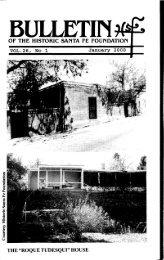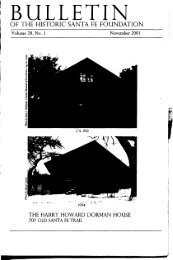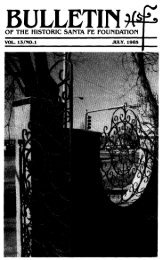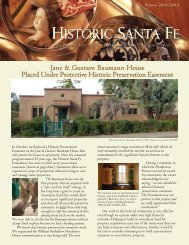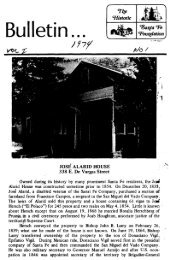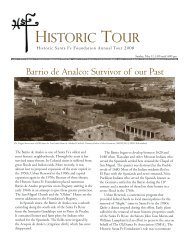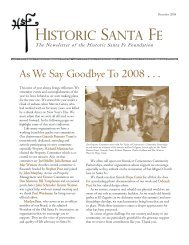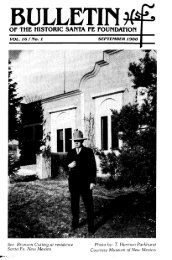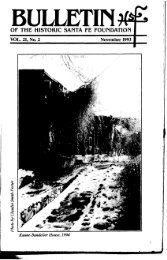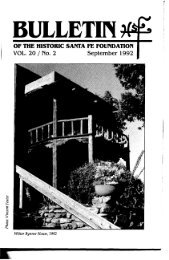James L. Johnson House - Historic Santa Fe Foundation
James L. Johnson House - Historic Santa Fe Foundation
James L. Johnson House - Historic Santa Fe Foundation
Create successful ePaper yourself
Turn your PDF publications into a flip-book with our unique Google optimized e-Paper software.
HISTORIC PRESERVATION EASEMENTS COME<br />
TO HSFF<br />
Tracey Connor. Board Member<br />
In 1995 the <strong>Historic</strong> <strong>Santa</strong> <strong>Fe</strong> <strong>Foundation</strong> helped shepherd the Cultural<br />
Properties Preservation Easement Act (the "Act") through the state<br />
legislature. The Act enables private citizens to establish historic preservation<br />
easements to protect historic structures, archaeological sites,<br />
cultural landscapes and traditional cultural properties. The <strong>Foundation</strong><br />
has established a program to hold, monitor and enforce historic preservation<br />
easements. Because this program is new to New Mexico, the<br />
<strong>Foundation</strong> is working with property owners, appraisers, accountants<br />
and city planners to educate and assist in understanding the benefits of<br />
these easements and the process of creating them.<br />
A historic preservation easement is a voluntary legal agreement made<br />
by a property owner to protect the unique historic resources on property<br />
by restricting the type and amount of development that may take<br />
place. Each easement's restrictions are tailored to the particular property<br />
and to the interests of the individual owner. The easement creates<br />
permanent legal assurances that the property, even as it passes from<br />
owner to owner, will retain its unique characteristics.<br />
The specific rights a property owner forgoes when granting a historic<br />
preservation easement are spelled out in each easement document. The<br />
owner and the <strong>Foundation</strong> identify the rights and restrictions on use that<br />
are necessary to protect the property. The <strong>Foundation</strong> has the right under<br />
the easement agreement to protect the property. The property periodically<br />
is inspected to ensure compliance with the easement restrictions<br />
and enforcement of the restrictions in the event they are violated.<br />
When a historic preservation easement is granted, the property owner<br />
retains title, and can use, sell, or leave the property to the family. Future<br />
owners of the property must abide by the easement's restrictions.<br />
The easement is recorded at the county recorder's office so that all<br />
future owners and lenders will learn about the easement restrictions.<br />
If the easement donor wishes to qualify for an income tax deduction,<br />
the federal tax laws require some form of public access or public viewing<br />
be available. If the property is an occupied residence, the public<br />
access requirement may be satisfied by allowing the <strong>Foundation</strong> to conduct<br />
two guided tours each year and permit people affiliated with educational,<br />
professional or historical societies to study the property.



